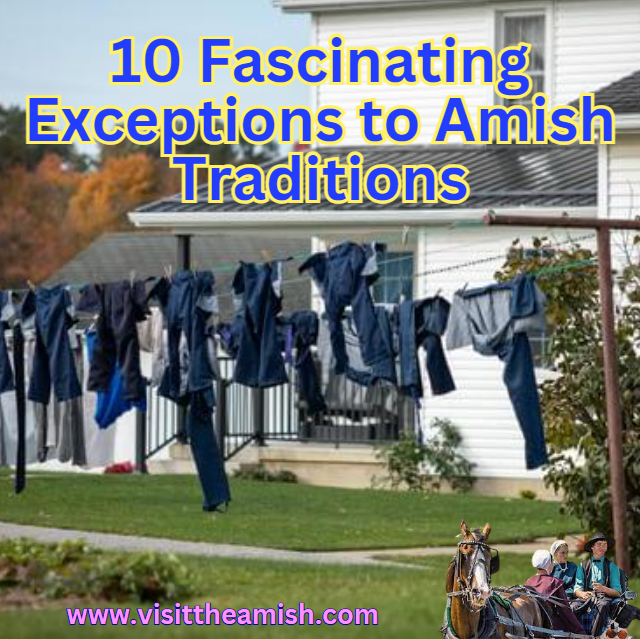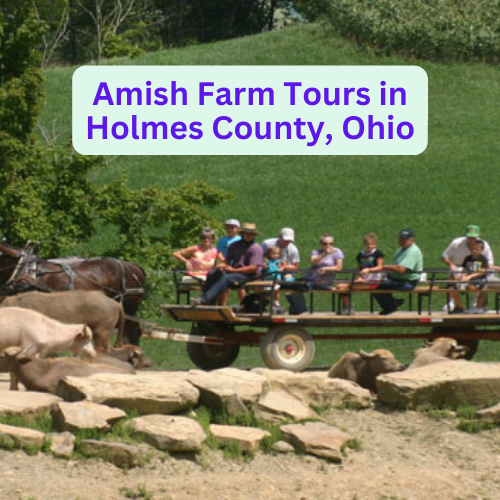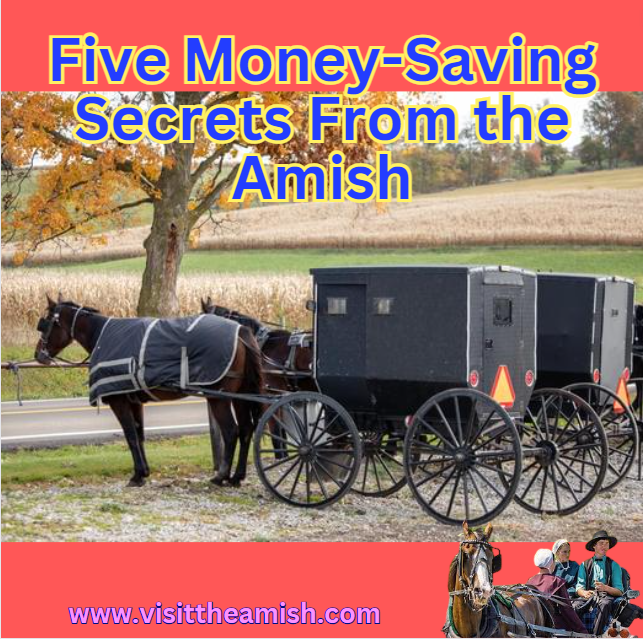Exploring the Unconventional: 10 Fascinating Exceptions to Amish Traditions
Within the fabric of Amish culture lie entrenched traditions and steadfast beliefs that shape their way of life. Yet, amidst these customary practices, there exist intriguing exceptions that challenge the norm, illustrating the dynamic spectrum of Amish communities and their diverse approaches to certain aspects of life.
While certain principles like plain clothing, pacifism, and observing Sunday closures endure universally among the Amish, nuances and exceptions are woven into their communities, revealing a fascinating tapestry of individuality within a collective culture.
1. Church Meeting Houses
The majority of Amish congregations hold church services in homes or existing structures, but a distinct minority, notably the Amish of Somerset County, Pennsylvania, gather in separate meetinghouses—an unconventional deviation from the norm. The Beachy Amish also build meeting houses.
The tradition of holding church services within the intimate setting of homes or existing structures is a hallmark of Amish congregational gatherings, fostering a sense of community and reinforcing familial ties. However, within the diverse landscape of Amish congregations, a distinct minority, notably exemplified by the Amish of Somerset County, Pennsylvania, diverges from this tradition by convening in separate meetinghouses—a notable deviation from the prevailing norm.
Home-Based Worship Traditions
Traditionally, the Amish have practiced worship services within the cozy confines of homes, often rotating the location among families within the congregation. These gatherings, held in familiar domestic settings, strengthen bonds among community members and reinforce the close-knit nature of Amish society.
Unconventional Gathering Spaces
In contrast to the prevalent custom of home-based worship, the Amish of Somerset County, Pennsylvania, opt for a different approach by congregating in purpose-built meetinghouses. These dedicated structures serve as centralized spaces exclusively designated for worship, diverging from the customary practice of utilizing residences for church services.
Purpose and Significance of Meetinghouses
The decision to gather in separate meetinghouses within these distinct Amish communities holds significance. Meetinghouses offer a formal and dedicated space solely devoted to religious gatherings, providing a setting conducive to communal worship, spiritual teachings, and church-related activities.
Community Identity and Differentiated Practices
The choice to convene in meetinghouses exemplifies the nuanced variations in Amish practices across different communities. This departure from home-based services underscores the unique identity and localized customs upheld by specific congregations, showcasing their autonomy in interpreting traditional practices.
Practical Considerations and Adaptations
The adoption of meetinghouses could stem from practical considerations or evolving community needs. It may accommodate larger congregations, provide stability to the worship environment, or reflect a desire for more structured and centralized religious settings while preserving the essence of communal worship.
Respect for Ordnung and Communal Consensus
The decision to establish meetinghouses often aligns with the collective agreements and guidelines outlined in the Ordnung—the set of regulations governing Amish communities. Such deviations are typically made through communal consensus and reflect a deliberate choice to adapt while adhering to established norms.
Preservation of Core Values
Despite this deviation in congregational gathering spaces, the underlying commitment to faith, community, and the preservation of Amish cultural values remains steadfast. The use of meetinghouses doesn’t dilute the core principles but showcases the adaptability within the fabric of Amish tradition.
In essence, the choice of the Amish of Somerset County, Pennsylvania, to gather in separate meetinghouses instead of homes for church services represents a unique expression of their communal worship practices. This departure highlights the diverse interpretations and localized adaptations of traditional customs within the multifaceted landscape of Amish congregations.
2. Beards
While growing a beard upon marriage is customary, the timeline and customs around beard growth vary widely. From growing a beard at baptism to some waiting until a certain age, these deviations underscore the nuanced traditions within Amish groups.
Indeed, within the rich tapestry of Amish customs, the practice of beard growth stands as a symbol of transition and adherence to cultural norms. However, the nuances surrounding the timeline and customs associated with beard growth among different Amish groups reflect the diverse and intricate traditions prevalent within their communities.
Symbolism of Beard Growth
For many Amish men, growing a beard symbolizes the transition into adulthood, marriage, and assuming familial responsibilities within the community. The act of growing a beard is steeped in tradition, reflecting maturity and a commitment to uphold the values of the community.
Varied Timelines for Beard Growth
The timing and customs linked to beard growth within Amish communities showcase intriguing variations. While growing a beard upon marriage is a customary practice, the specific timing can differ significantly. For instance:
- Baptism as a Milestone: Some Amish groups associate beard growth with baptism, viewing it as a pivotal life event that marks the onset of adulthood. In these communities, individuals may begin growing a beard upon baptism, signifying their spiritual commitment and readiness for adult responsibilities.
- Age-Related Customs: Contrary to immediate beard growth upon marriage, certain Amish customs dictate the commencement of beard growth at a designated age. For example, unmarried men might wait until reaching a certain age, such as 40, before cultivating a beard, marking a transition to maturity irrespective of marital status.
- Marriage and Household Establishment: Other customs may link beard growth to specific milestones, such as establishing one’s own household post-marriage. In these cases, individuals might delay growing a beard until they settle into their own homes, symbolizing independence and readiness for family life.
Diversity Within Amish Groups
These deviations in beard growth traditions underscore the diverse cultural practices and interpretations existing among various Amish groups. The nuanced variations reflect the unique customs upheld within specific communities, shaped by their distinct interpretations of tradition and adherence to Ordnung—the set of rules governing their way of life.
Adherence to Cultural Identity
While the timeline for beard growth varies, the significance remains constant: the cultivation of a beard serves as a visible marker of adulthood and commitment to Amish values. These customs underscore the intricate layers of tradition, familial rites, and the nuanced ways in which different Amish groups express their cultural identity.
Continuity Amidst Change
Amidst these differences, the practice of beard growth remains a unifying tradition within the diverse tapestry of Amish culture. The variations in timelines and customs surrounding beard growth signify the evolving nature of tradition while maintaining the core essence of Amish identity across their communities.
In essence, the diverse timelines and customs associated with beard growth among Amish groups exemplify the intricate and multifaceted nature of their cultural traditions, reflecting the ways in which these communities interpret and express their shared values while embracing individual nuances within their societal fabric.
3. Public Electricity
Traditionally shunning public electric grids, the “electric” New Order Amish break this trend by permitting connections to public power, deviating from the widespread rejection of this convenience.
The New Order Amish, recognized for their progressive stance within the broader Amish community, notably diverge from the traditional rejection of public electric grids—a departure that sets them apart by embracing a modern convenience that other Amish groups typically shun.
Traditional Avoidance of Public Electric Grids
Across traditional Amish communities, a fundamental belief revolves around avoiding direct connections to public electric grids. This practice stems from a desire to uphold simplicity, limit dependence on modern technology, and preserve a distinct lifestyle centered around community, family, and traditional values.
The Electric New Order Amish
In contrast to the prevalent rejection of public power, the New Order Amish exhibit a more liberal approach by permitting connections to public electric grids. This departure from the norm reflects their willingness to embrace select aspects of modernity while still maintaining a balance between tradition and practicality.
Adaptation to Modern Needs
The New Order Amish’s acceptance of public power connections acknowledges the changing needs and dynamics within their communities. This pragmatic adaptation allows them to leverage certain modern conveniences, such as electricity, while exercising discernment in its utilization to avoid excessive reliance on technology.
Balancing Tradition and Convenience
For the New Order Amish, the decision to permit connections to public power grids signifies a deliberate attempt to balance tradition with the pragmatic realities of modern life. They carefully navigate the integration of certain technological conveniences while preserving core Amish values.
Community-Specific Policies
The acceptance of public power connections within the New Order Amish communities often stems from community-specific policies and discussions. These decisions are made collectively, taking into account the community’s values, beliefs, and the potential impact on their way of life.
Respect for Ordnung
The New Order Amish’s acceptance of public power reflects their interpretation and adherence to their Ordnung—the set of rules governing their community. This deviation is not a rejection of tradition but rather a nuanced application of their guiding principles.
Adapting to Changing Realities
As society evolves and technologies advance, the New Order Amish’s acceptance of certain modern conveniences, such as public power connections, signifies a willingness to navigate the complexities of modernity while remaining rooted in their cultural heritage.
In summary, the New Order Amish’s departure from the traditional rejection of public electric grids showcases their willingness to adapt selectively to modern amenities while preserving the essence of Amish values and community cohesion. This nuanced approach represents a delicate balance between embracing practicality and upholding cherished traditions within their evolving way of life.
4. SMV Triangle
With over 90% of Amish using the Slow-Moving-Vehicle triangle, the Swartzentruber group stands out by rejecting this symbol and electric lighting on their carriages—an exception to the widely adopted safety measure.
The Slow-Moving-Vehicle (SMV) triangle is a recognized safety symbol widely adopted among the Amish community to enhance visibility and promote safety on roads, particularly for their horse-drawn carriages. However, within the rich tapestry of Amish traditions, the Swartzentruber group diverges from this common practice, illustrating their distinctive approach to safety and adherence to traditional customs.
Prevalence of the SMV Triangle
Across Amish communities, the use of the SMV triangle on horse-drawn carriages is commonplace, with an overwhelming majority, estimated at over 90%, adopting this safety measure. The brightly colored triangle serves as a visual warning for motorists, alerting them to the slow-moving vehicles on roadways.
Swartzentruber Group’s Rejection
In contrast to the widespread acceptance of the SMV triangle, the Swartzentruber group stands apart by rejecting this safety symbol on their carriages. This departure from the norm signifies their commitment to adhering strictly to traditional customs and beliefs, even in matters concerning safety regulations.
Emphasis on Simplicity and Tradition
The Swartzentruber Amish’s rejection of the SMV triangle aligns with their broader principles of simplicity and nonconformity. They prioritize the preservation of traditional practices, often forgoing modern safety measures that conflict with their deeply entrenched cultural norms.
Alternative Safety Measures
Despite eschewing the SMV triangle, the Swartzentruber group employs alternative safety precautions in lieu of modern lighting or reflective symbols on their carriages. They rely on traditional, non-electric methods, such as reflective tape or lanterns, to enhance visibility while maintaining adherence to their customs.
Cultural Identity and Nonconformity
For the Swartzentruber Amish, the rejection of the SMV triangle extends beyond safety considerations; it’s a symbol of their unwavering commitment to preserving their unique cultural identity and maintaining separation from modern societal influences.
Respect for Ordnung and Tradition
The decision to forgo the SMV triangle underscores the Swartzentruber Amish’s adherence to the rules outlined in their Ordnung, a set of regulations governing their community. This adherence to tradition and specific rules highlights the significance they place on maintaining the sanctity of their cultural practices.
Respectful Coexistence
While the rejection of the SMV triangle may seem at odds with modern safety standards, it represents a respectful coexistence between traditional values and contemporary expectations. It’s a reminder of the diverse interpretations and practices within the broader Amish community, each stemming from deeply held convictions and cultural norms.
In essence, the Swartzentruber Amish’s refusal to adopt the SMV triangle on their carriages signifies their unwavering commitment to traditional values, emphasizing the importance of maintaining their cultural identity and adhering strictly to their community’s established norms, even in matters of safety regulation.
5. Cameras
Though a prevalent belief prohibits posing for photos or appearing in videos, certain Amish individuals and progressive churches may deviate, participating in media appearances or allowing personal representation.
Within the traditional fabric of Amish culture, a longstanding belief discourages posing for photographs or appearing in videos—a practice deeply rooted in their values of humility, simplicity, and a desire to avoid undue attention or vanity. However, within this overarching cultural norm, there are intriguing exceptions found among certain individuals and more progressive Amish churches that diverge from the conventional stance on media representation.
Cultural Reluctance Toward Media Exposure
The traditional belief among the Amish community rejects visual media, emphasizing a humble and modest lifestyle devoid of personal glorification. This reluctance stems from a desire to preserve their identity and safeguard against the potential negative impacts of modernity on their communal values.
Exceptions among Progressive Churches
Amid this customary stance, some more progressive Amish churches exhibit a greater openness toward media representation. These communities may deviate from the traditional norm, allowing for limited participation in media appearances or granting permission for personal representation in certain contexts.
Individual Discretion
While the broader cultural norm discourages participation in visual media, individual Amish members may exercise personal discretion, sometimes permitting their representation in photographs or videos on a case-by-case basis. Such deviations often reflect individual interpretations or allowances within specific families or communities.
Contextual Considerations
The exceptions to the ban on media representation are often subject to particular contexts or circumstances. For instance, some Amish individuals may agree to be photographed for educational or documentary purposes, respecting the intent behind such projects while carefully weighing the impact on their cultural values.
Balancing Tradition and Practicality
The willingness of certain Amish individuals or progressive churches to participate in media representation underscores a delicate balance between adhering to traditional values and navigating pragmatic considerations. Such deviations are often a result of thoughtful deliberation and an evolving approach to engaging with the outside world.
Embracing Modern Communication
In an era marked by technological advancements and increased connectivity, some Amish individuals or communities acknowledge the role of media representation in modern communication. Their participation in limited media appearances may reflect a willingness to adapt to contemporary contexts while preserving core cultural values.
In summary, while the prevalent Amish belief advises against posing for photos or appearing in videos, exceptions exist among certain individuals and more progressive churches. These deviations underscore the complexities within Amish communities as they navigate the tension between preserving tradition and engaging with evolving societal norms and practical considerations in the modern world.
6. Alcohol
Within the intricate tapestry of Amish communities, the general ethos toward alcohol consumption is one of moderation and restraint, aligning with their values of simplicity and temperance. However, amid this overarching cultural norm, there are nuanced deviations present in certain Amish groups that showcase a more relaxed stance on alcohol or grapple with issues related to its misuse.
Cultural Norms of Moderation
For the majority of Amish communities, the cultural practice dictates a cautious approach to alcohol consumption. Moderation is key, and many adhere to a strict principle of temperance, limiting alcohol intake primarily for health purposes or in modest amounts during social or ceremonial occasions.
Relaxed Attitudes in Specific Communities
Contrary to the prevalent norm, some Amish settlements exhibit a more relaxed stance toward alcohol use. Within these communities, individuals may be more lenient in their views, allowing for occasional or moderate consumption of alcohol without the stringent restrictions observed in other groups.
Dealing with Misuse and Challenges
In some pockets of Amish society, the relaxed approach to alcohol consumption has resulted in issues related to its abuse. Certain communities may grapple with instances of alcohol misuse or its adverse effects, leading to concerns within these groups and efforts to address such challenges.
Individual and Community Responses
Responses to deviations in alcohol use vary within Amish communities. While some individuals or groups may embrace a more permissive attitude toward alcohol, others remain staunchly committed to the traditional practice of temperance. Community leaders and church authorities often play a crucial role in addressing concerns related to alcohol misuse, emphasizing guidance and support for those affected.
Preservation of Traditional Values
Despite these deviations, the majority of Amish communities uphold the core values of temperance, simplicity, and communal harmony. The occasional variations in attitudes toward alcohol within certain groups do not diminish the broader commitment to preserving traditional customs and maintaining the integrity of their cultural norms.
Cultural Sensitivity and Nuanced Perspectives
Understanding these nuances within Amish communities requires sensitivity to their unique cultural context. The variations in attitudes toward alcohol use serve as a reminder of the multifaceted nature of Amish society, where localized practices intersect with broader cultural norms.
In summary, while the customary practice among the Amish is one of moderation in alcohol consumption, deviations in attitudes exist within specific communities. These deviations underscore the complexities and diverse perspectives within Amish society, demonstrating the varied ways in which cultural norms are interpreted and navigated within different groups while preserving the overarching values that define their way of life.
7. Raising Tobacco
Most Amish eschew tobacco farming, but in Lancaster County and related communities, cultivating tobacco for cash has long been a tradition, diverging from the broader practice.
The cultivation of tobacco within certain Amish communities, notably in Lancaster County and its affiliated regions, stands as a notable departure from the predominant practice of eschewing tobacco farming observed among the broader Amish population.
Historical Tradition in Lancaster County
In Lancaster County and its related communities, the cultivation of tobacco as a cash crop traces its roots back through generations. This longstanding tradition has embedded itself deeply within the fabric of these specific Amish settlements, becoming an integral part of their agricultural practices and economic pursuits.
Divergence from Widespread Amish Practice
Tobacco farming diverges significantly from the general Amish practice of abstaining from cultivating tobacco. While the broader Amish community typically avoids tobacco farming due to ethical considerations and societal principles, the Lancaster County Amish hold a unique perspective, allowing for the cultivation of tobacco as a means of generating income.
8. No Hired Drivers
While hiring drivers for travel is commonplace, the Swartzentruber Amish maintain strict limitations, relying on emergency situations for hired drivers and favoring bus and train services for longer distances.
The Swartzentruber Amish, known for their adherence to traditional and conservative practices within the broader Amish community, maintain a distinct approach to transportation that sets them apart in their reliance on hired drivers and their preferences for long-distance travel.
Strict Limitations on Hired Drivers
In contrast to the more common Amish practice of hiring drivers, often referred to as “Amish taxis,” for various travel needs, the Swartzentruber Amish impose stringent restrictions on this practice. They strictly limit the hiring of drivers to emergency situations, emphasizing a commitment to self-reliance and communal support within their tightly-knit communities.
Emphasis on Emergency Situations
For the Swartzentruber Amish, hiring drivers is reserved for urgent or unforeseen circumstances that necessitate immediate travel assistance. This practice underscores their conviction to minimize external reliance, prioritizing self-sufficiency while using hired drivers as a last resort measure in critical situations, such as medical emergencies or urgent family needs.
Preference for Bus and Train Services
In lieu of hiring drivers for longer journeys, the Swartzentruber Amish demonstrate a preference for utilizing public transportation options such as bus and train services. Embracing these modes of travel enables them to access distant destinations while adhering to their communal principles, favoring shared transportation means over individualized chauffeur services.
Commitment to Traditional Values
This approach to transportation exemplifies the Swartzentruber Amish’s unwavering commitment to traditional values, emphasizing community cohesion, humility, and self-reliance. By limiting hired drivers and favoring shared modes of transportation, they uphold their cultural norms while navigating the necessities of modern travel.
Reinforcement of Community Bonds
The emphasis on minimizing hired drivers and utilizing public transportation not only reinforces their commitment to traditional values but also strengthens the bonds within their community. Collaborative travel arrangements foster unity and solidarity among the Swartzentruber Amish, enhancing mutual support and communal interdependence.
Adherence to Established Ordnung
The Swartzentruber Amish’s transportation practices align closely with the specific rules and guidelines outlined in their Ordnung—the set of regulations that govern their community. These practices reflect their collective dedication to preserving the sanctity of their cultural traditions while adapting to contemporary travel needs within the boundaries of their established customs.
In summary, the Swartzentruber Amish’s approach to transportation, characterized by stringent limitations on hired drivers and a preference for shared public transportation, encapsulates their steadfast commitment to communal values and self-sufficiency. This distinctive approach serves as a testament to their enduring dedication to upholding traditional customs while navigating the complexities of modern-day travel necessities.
9. Volunteer Firefighting
Lancaster County’s Amish communities showcase active participation in volunteer firefighting—a civic engagement largely unique to this region within Amish settlements.
The involvement of Lancaster County’s Amish communities in volunteer firefighting represents a remarkable departure from the traditional roles often associated with Amish societal engagement. Within the broader spectrum of Amish settlements, this proactive participation in firefighting duties stands as a distinctive feature, demonstrating a unique approach to civic responsibility and community involvement.
Unconventional Civic Engagement
Traditionally, the Amish maintain a strong commitment to their communities but typically within spheres closely aligned with their lifestyle—such as agriculture, family, and church-centered activities. However, in Lancaster County, this community showcases an atypical and hands-on approach to civic engagement by actively volunteering in firefighting roles.
Unique Regional Tradition
The active involvement of Lancaster County’s Amish in firefighting duties isn’t merely an isolated anomaly but rather an established and ingrained tradition specific to this geographical area. This distinctive regional practice highlights the Amish community’s willingness to step beyond conventional boundaries, contributing to the broader safety and well-being of the locality.
Mutual Aid and Support
The participation of the Amish in volunteer firefighting signifies a mutual commitment to the safety and welfare of their neighborhoods, fostering a sense of unity and collaboration between the Amish and the non-Amish residents. Their readiness to engage in firefighting duties underscores a shared commitment to community safety, transcending cultural boundaries.
Adherence to Community Needs
The decision of Lancaster County’s Amish communities to actively participate in firefighting duties aligns with their values of communal support and self-reliance. By integrating firefighting roles into their communal responsibilities, they ensure the availability of vital services within their neighborhoods, displaying adaptability while upholding the fabric of their societal values.
Positive Intercommunity Relations
This distinctive involvement in firefighting duties also fosters positive intercommunity relations, bridging cultural gaps and facilitating understanding between the Amish and the wider community. It serves as a conduit for building stronger relationships and mutual respect, promoting cooperation and solidarity during times of need.
In essence, the active engagement of Lancaster County’s Amish communities in volunteer firefighting epitomizes a remarkable convergence of traditional values and proactive civic involvement. This unique regional tradition not only contributes to community safety but also symbolizes a collaborative spirit, showcasing the adaptability and willingness of the Amish to actively contribute to the welfare of their neighborhoods in ways that extend beyond conventional boundaries.
10. Assurance of Salvation
While many Amish hold a “living hope” of salvation, some churches, notably the New Order Amish, profess an assurance of salvation—a divergence in beliefs within the broader Amish faith.
These exceptions to Amish traditions reveal a rich tapestry of diversity within their communities, challenging the stereotypical perceptions and emphasizing the multifaceted nature of Amish culture. While grounded in tradition, these deviations showcase the flexibility and unique interpretations that exist within the larger framework of Amish customs, illustrating a nuanced spectrum of practices and beliefs within these close-knit communities.







